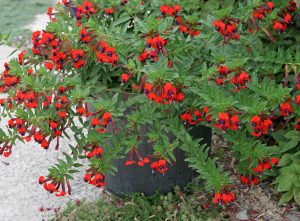 Cuphea llavea is one of about 260 species of Cupheas in the loosestrife family (Lythraceae). This fast growing tender broadleaf evergreen sub-shrub native to Mexico is sold as an annual or houseplant in cooler climates, sometimes under the synonym C. blepharophylla. It is often a conversation plant due to its unique flower shape.
Cuphea llavea is one of about 260 species of Cupheas in the loosestrife family (Lythraceae). This fast growing tender broadleaf evergreen sub-shrub native to Mexico is sold as an annual or houseplant in cooler climates, sometimes under the synonym C. blepharophylla. It is often a conversation plant due to its unique flower shape. 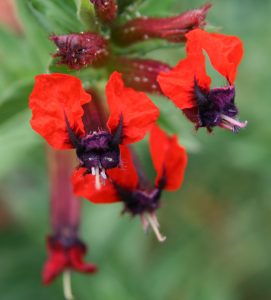 The common name bat-faced cuphea comes from the resemblance of the ends of the flower to a tiny bat face but it may also be called red cuphea or just cuphea (along with several other species; orange bat-faced cuphea is a different species, C. oreophila.)
The common name bat-faced cuphea comes from the resemblance of the ends of the flower to a tiny bat face but it may also be called red cuphea or just cuphea (along with several other species; orange bat-faced cuphea is a different species, C. oreophila.) 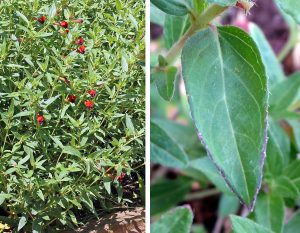 Plants can grow up to 2½ feet tall, but when grown as seasonal annuals generally only become 12-18 inches tall with an equal spread. They have a rounded, bushy habit and the foliage remains fresh all season if watered sufficiently. The stems are crowded with alternate dark green, thick, sandpapery leaves up to 3” long. Each ovate leaf is pointed and hairy. The foliage can tolerate light frost but not a hard freeze.
Plants can grow up to 2½ feet tall, but when grown as seasonal annuals generally only become 12-18 inches tall with an equal spread. They have a rounded, bushy habit and the foliage remains fresh all season if watered sufficiently. The stems are crowded with alternate dark green, thick, sandpapery leaves up to 3” long. Each ovate leaf is pointed and hairy. The foliage can tolerate light frost but not a hard freeze.  Bat-faced cuphea begins blooming in late spring and continues until frost, producing clusters of numerous flowers in the leaf axils. Each flower has a one inch long, hairy purple calyx with two upward facing red petals at the end, forming the “ears” to go with the “bat face”. The remaining four petals are just little spiny remnants in the species but in some cultivars these are fully developed. Flowers are attractive to hummingbirds, bees and butterflies. The small, brown lentil-shaped seeds are found at the base of spent flowers that remain on the plant.
Bat-faced cuphea begins blooming in late spring and continues until frost, producing clusters of numerous flowers in the leaf axils. Each flower has a one inch long, hairy purple calyx with two upward facing red petals at the end, forming the “ears” to go with the “bat face”. The remaining four petals are just little spiny remnants in the species but in some cultivars these are fully developed. Flowers are attractive to hummingbirds, bees and butterflies. The small, brown lentil-shaped seeds are found at the base of spent flowers that remain on the plant. 
 There are a number of cultivars available which vary from the species including:
There are a number of cultivars available which vary from the species including:
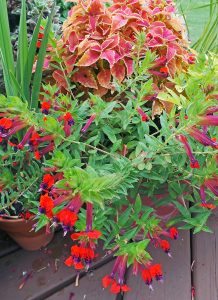 Plant bat-faced cuphea in annual beds, along the edges of borders or paths, or in containers – including hanging baskets – where its unique flowers can be appreciated up close. Combine bat-faced cuphea with plants with purple foliage or bright purple flowers to complement the dark “faces” of the flowers or red flowers, such as bright red impatiens, to coordinate with the “ears”. Use it alone or mixed with other plants such as coleus and ‘Blackie’ sweet potato vine in containers. Container-grown plants can be moved indoors to overwinter in a bright, sunny location with at least four hours of direct sun. Reduce watering and keep relatively cool (in the 60°F’s).
Plant bat-faced cuphea in annual beds, along the edges of borders or paths, or in containers – including hanging baskets – where its unique flowers can be appreciated up close. Combine bat-faced cuphea with plants with purple foliage or bright purple flowers to complement the dark “faces” of the flowers or red flowers, such as bright red impatiens, to coordinate with the “ears”. Use it alone or mixed with other plants such as coleus and ‘Blackie’ sweet potato vine in containers. Container-grown plants can be moved indoors to overwinter in a bright, sunny location with at least four hours of direct sun. Reduce watering and keep relatively cool (in the 60°F’s).  Grow bat-faced cuphea in full sun in the ground or in containers. Provide regular moisture, although plants will tolerate dry conditions occasionally. Fertilize plants in containers several times during the summer months. Pinch back or shear if plants become too leggy later in the growing season. This low maintenance plant has few insect or disease problems but may be infested with whiteflies, mealybugs or aphids. C. llavea is propagated from seed, short softwood cuttings taken in late spring, or large plants can be divided. Start seeds indoors 10-12 weeks before the average last date of frost. The seeds need light to germinate so just press into the soil surface or barely cover. Seeds should germinate in 8-10 days if maintained at 70°F.
Grow bat-faced cuphea in full sun in the ground or in containers. Provide regular moisture, although plants will tolerate dry conditions occasionally. Fertilize plants in containers several times during the summer months. Pinch back or shear if plants become too leggy later in the growing season. This low maintenance plant has few insect or disease problems but may be infested with whiteflies, mealybugs or aphids. C. llavea is propagated from seed, short softwood cuttings taken in late spring, or large plants can be divided. Start seeds indoors 10-12 weeks before the average last date of frost. The seeds need light to germinate so just press into the soil surface or barely cover. Seeds should germinate in 8-10 days if maintained at 70°F.
With its beautiful and distinct bat-shaped flowers, the bat faced cuphea (Cuphea llavea) makes for an eye-catching addition to any garden. However like most plants it can fall victim to various diseases that affect its health and appearance. As a bat faced cuphea owner, it’s important to know how to identify, treat, and prevent the most common afflictions. This comprehensive guide covers all you need to know about keeping your cherished plant thriving.
Overview of Bat Faced Cuphea Diseases
Some diseases that frequently impact bat faced cuphea plants include
- Powdery mildew
- Leaf spot
- Root rot
- Botrytis blight
- Virus diseases
These diseases are often caused by fungal or bacterial infections Excess moisture, poor air circulation, and unsanitary growing conditions can create an environment where diseases take hold and spread Being able to recognize the signs and act quickly is key to saving an affected plant.
Powdery Mildew
Powdery mildew is one of the most prevalent fungal diseases of bat faced cuphea. It manifests as a white, powdery coating on leaves, stems, flowers, and other above-ground parts of the plant. Affected areas may become twisted, curled, or stunted.
Causes
Powdery mildew thrives in humid, shady environments. Overcrowding and inadequate air flow also enable it to spread easily.
Treatment
- Improve air circulation around plants.
- Apply a fungicide specifically for powdery mildew.
- Remove and destroy severely infected plant parts.
Leaf Spot
Leaf spot refers to dark, diseased lesions that form on bat faced cuphea foliage. These spots enlarge over time and may cause leaves to yellow, wither, and drop.
Causes
Fungal and bacterial infections often cause leaf spot outbreaks, especially in wet conditions. Overhead watering spreads pathogens to leaves.
Treatment
- Apply copper-based fungicide sprays at first sign of infection.
- Remove and destroy leaves with advanced infections.
- Space plants properly and avoid wetting foliage when watering.
Root Rot
Root rot causes roots to become brown, mushy, and unable to absorb nutrients. Above ground, symptoms include wilting, stunted growth, and leaf drop.
Causes
Excess moisture from overwatering or poor drainage encourages fungal root rot pathogens.
Treatment
- Allow soil to dry out between waterings.
- Repot plants in fresh, sterile soil if rot is advanced.
- Use well-draining soil and improve drainage.
Botrytis Blight
This fungal disease forms fuzzy gray mold on flowers, stems, leaves, and buds. Affected parts turn brown or black.
Causes
Cool, very humid or wet conditions favor development of botrytis blight.
Treatment
- Remove and destroy infected plant material immediately.
- Apply fungicide to protect healthy plant tissues.
- Improve air flow and reduce humidity around plants.
Virus Diseases
Viruses cause mottling, distortion, ringspots, stunted growth, and other symptoms. Once contracted, viruses remain in the plant indefinitely.
Causes
Viruses spread via insect pests, human contact, contaminated tools, and infected nursery stock.
Prevention
- Isolate or dispose of diseased plants.
- Control insects that can transmit viruses.
- Sterilize tools between uses.
Preventing Bat Faced Cuphea Diseases
While some diseases are unavoidable, good cultural practices go a long way in keeping bat faced cuphea healthy and resilient:
- Choose disease-resistant cultivars when available
- Provide good air circulation and avoid overcrowding
- Use sterilized, fresh potting mix
- Avoid excess moisture
- Disinfect tools between plants
- Remove spent flowers and foliage
- Monitor for early symptoms and treat promptly
By staying vigilant and responding quickly when diseases appear, you can help your beloved bat faced cuphea put its best, healthiest blooms forward. Refer to this guide anytime unusual symptoms appear to diagnose and treat problems early. With proper care, your plant will continue gracing your garden with its wonderfully unique flowers for many seasons to come.
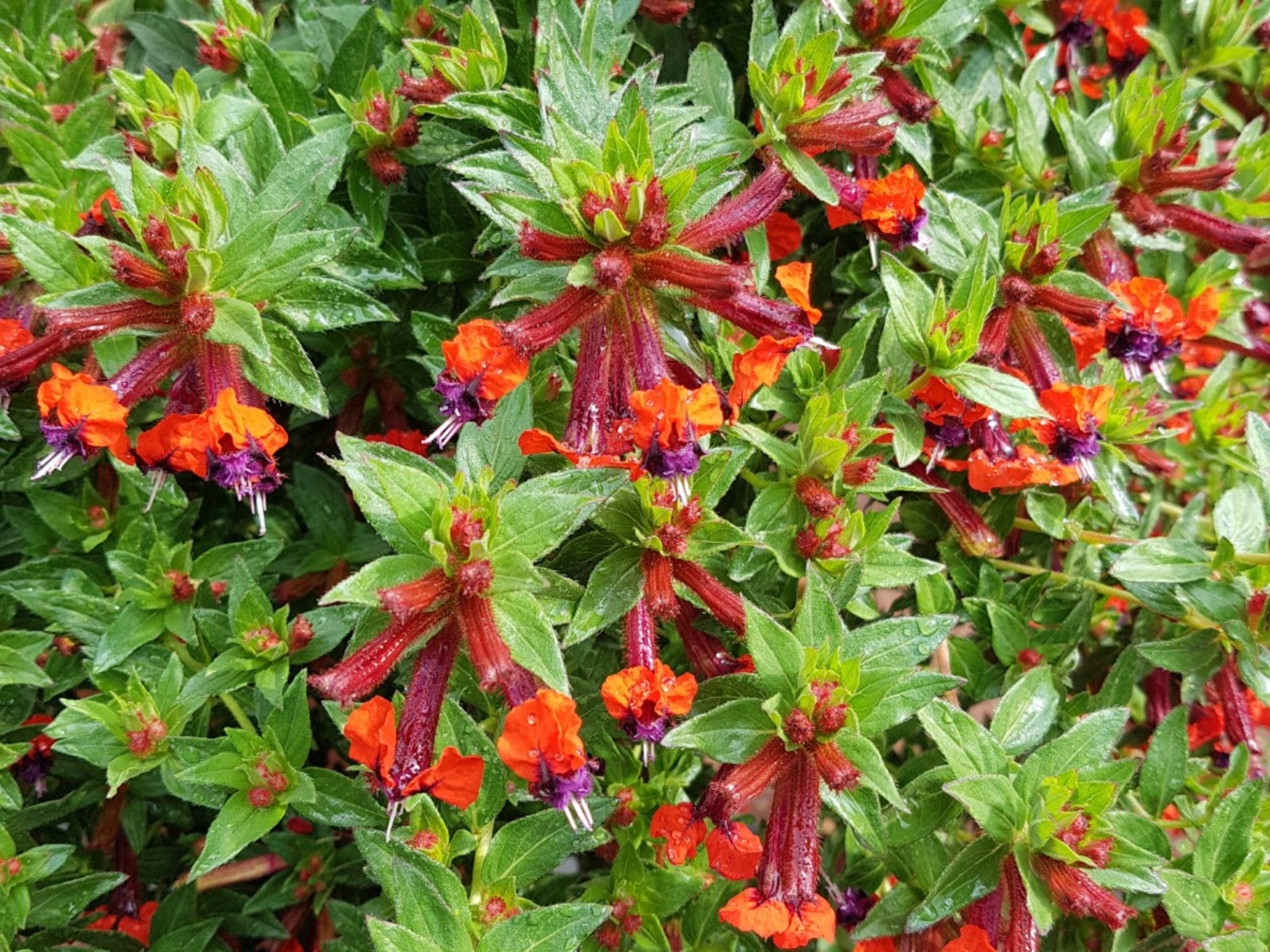
Featured Articles by Season




Ask Your Gardening Question
If you’re unable to find the information you need, please submit your gardening question here:
Bat Faced Cuphea
FAQ
How do you save Cuphea?
How to care for bat face Cuphea?
Is bat face Cuphea poisonous?
What is a bat face Cuphea plant?
Native to Central America and Mexico, bat face cuphea plant (Cuphea llavea) is named for its interesting little bat-faced blooms of deep purple and bright red. Read this article for helpful informatio
Why is it called a bat faced Cuphea?
It gets its common name of bat faced cuphea from the striking resemblance of its blooms to the face of a bat. Other common names include bunny ears, cuphea, red cuphea, St. Peter’s plant, and tiny mice. This broadleaf evergreen sub-shrub is native to Mexico and other parts of Central America.
What is a bat-faced Cuphea?
The common name bat-faced cuphea comes from the resemblance of the ends of the flower to a tiny bat face but it may also be called red cuphea or just cuphea (along with several other species; orange bat-faced cuphea is a different species, C. oreophila.) Bat-faced cuphea produces many stems (L) with pointed, hairy ovate leaves (R).
How do you care for a bat faced Cuphea?
For best results, provide plants with: Organic soil. Full sun or part shade, depending on where you live. Regular water. All-purpose fertilizer. Bat-faced cuphea is fairly low maintenance. You can perform some light tip pruning or pinching if plants become too leggy.
